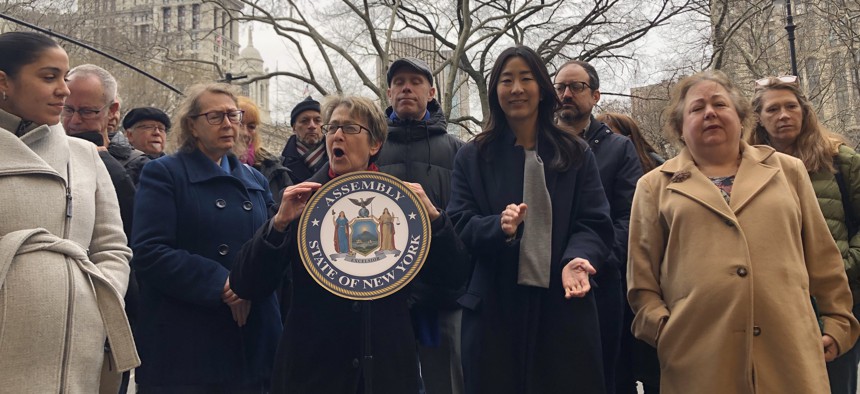Policy
Lawmakers rally against housing density near New York City Hall
The governor has proposed repealing floor area ratio limits to allow more development. Some prominent Democrats say that amounts to a developer handout.

With just a week before the state budget deadline, the fight over density is just another issue that has split Democrats. Jeff Coltin
Manhattan lawmakers and anti-development advocates rallied near New York City Hall on Friday demanding that the state keep housing density limits in the city as they are. While Gov. Kathy Hochul included a provision to lift the density cap (which dates to 1961) as part of her housing agenda, they argued that it would only result in more luxury apartments without affordable units. With just a week before the state budget deadline, the fight over density is just another issue that has split Democrats.
In New York City and other urban areas, density is determined by the floor area ratio, or the total floor area of a building in relation to the size of the plot. The higher the floor area ratio, commonly referred to as FAR, the more densely developers can build. For the past six decades, the state has imposed a residential FAR cap of 12 in the city, meaning that the total floor area of any residential building can’t exceed 12 times the square footage of the lot where it’s built. That helps explain why high-profile new residential developments are often pencil-thin – if developers want to maximize height, they need to sacrifice space on each floor. Hochul pitched lifting the cap to help the state reach her goal of 800,000 new units of housing over the next decade.
State Sen. Liz Krueger and Assembly Member Deborah Glick, both longtime and prominent members of the Legislature, attended the rally against lifting the FAR cap and made the case that the proposal would amount to a giveaway for developers. “All these empty luxury units just reinforces how much money is being made in real estate… they can actually leave them empty and still be making money,” Krueger said. Her chamber rejected the governor’s plan to lift the cap.
Glick, whose chamber also nixed the proposal in its one-house budget proposal, said that lifting the cap would do nothing to solve the real problems driving the housing crisis in New York City. “There is no reason, there’s no rationale, for making all of New York (an) as of right playground for the developers for luxury housing, when the crisis is in affordable housing,” she told City & State after the rally. Glick expressed confidence that the majority of Democratic state lawmakers in the Legislature are on her side.
Assembly Member Grace Lee and New York City Council Member Chris Marte, who both represent Lower Manhattan, also spoke at the rally.
But that’s not to say that all Democrats agree that the cap should stay in place. On Thursday, City Council Speaker Adrienne Adams co-wrote an op-ed in the Daily News expressing her support for the governor’s proposal and its necessity to build more affordable housing. “Maintaining this arbitrary cap flies in the face of all of our city’s fair housing goals,” Adams wrote. “We can no longer allow certain areas of our city to pull up the drawbridge against a crucial citywide housing push to create a fairer, more prosperous city.”
Mayor Eric Adams has also expressed his support for lifting the cap, including it among his top budget priorities.
Opponents of lifting the FAR cap have engaged in an aggressive offensive against the governor’s proposal, led in large part by Andrew Berman, the head of the Village Preservation Society. “We have a system set up where people can send emails to every member of the state Legislature to urge them to hold the line, as the Senate and the Assembly did,” Berman told City & State. “And we’ve generated tens of thousands of letters that way.” Berman said that people like the governor want “Dubai-level density,” that would result only in serving wealthy developers and “destroying the character of our neighborhoods.”

